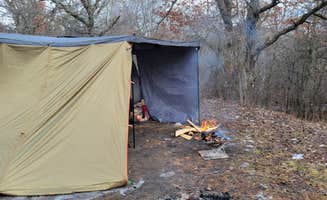South of Sand Dunes State Forest offers primitive camping opportunities on Minnesota DNR land approximately 45 miles northwest of Minneapolis. This rustic camping area features sandy soil conditions typical of the region's glacial outwash plains, with elevation ranging between 950-1,000 feet. Forest roads in this area are generally accessible to standard vehicles during dry weather, though recent rainfall can create challenging conditions on some sections.
What to do
Wildlife watching: The forest area hosts diverse bird populations including sandhill cranes. "Quiet with lots of different bird sounds. This is a nice quiet area," notes one visitor to South of Sand Dunes State Forest. Birdwatchers should bring binoculars and exercise caution around nesting areas.
Hammock camping: Sandy soil with scattered pine stands creates ideal hammock setup conditions. "I was able to walk in and find an incredible spot to camp and lay in my hammock," shares one camper who appreciates the proximity to urban areas.
Night sky observation: Limited light pollution provides stargazing opportunities on clear nights. Several campers mention the "silent nights, stars overhead" as highlights of their camping experience. Forest cover varies between sites, so locate clearings for optimal viewing.
What campers like
Accessibility from urban areas: The forest's proximity to Minneapolis makes it popular for quick getaways. "I love that it's so close to home," explains one camper who appreciates the convenient location for spontaneous outdoor experiences.
Multiple site options: The forest roads offer various pull-off camping spots. "Great spot. Plenty of parking. Best for straight vehicles or very small trailers," reports a visitor. Sites vary in size and tree coverage, with some areas better suited for smaller setups.
Peace and quiet: Most campers report relatively peaceful conditions, especially on weekdays. "Came back on a warm weekend. A bit more traffic, but after 12 p.m., not much of anything," notes a return visitor who found the area consistently serene during afternoon hours.
What you should know
Vehicle traffic considerations: Forest roads can be busier than expected. "This road is pretty busy for a dirt forest road and people fly down it. Almost got hit a few times walking," cautions a visitor to South of Sand Dunes State Forest. Exercise caution when walking along roadways, especially with children or pets.
Road closures and access restrictions: Recent management changes have affected access to some areas. "A lot of the side roads are closed to motor vehicles due to some issues they had a couple years ago but are now taken care of like people dumping," explains one camper. Check current regulations before arrival.
Cell service limitations: Connectivity is minimal throughout the forest. One camper notes "weak cell service but manageable" while others report "zero bars on the phone." Download maps before arrival and bring physical navigation tools as backup.
Tips for camping with families
Poison ivy awareness: Teach children to identify and avoid poison ivy, which is prevalent in the area. "Lots of poison ivy. Weak cell service but manageable," warns one visitor to South of Sand Dunes State Forest. Consider bringing poison ivy wash solutions as precaution.
Wildlife interactions: The area supports diverse wildlife including nesting birds. "Sand storks are very protective. Stay away from them. They attack," advises one camper who encountered territorial birds. Maintain appropriate distance from nesting areas.
Site selection for family camping: Choose sites away from main traffic areas for safety. Several campers note that spots farther down the forest roads tend to be quieter with less passing traffic, though site sizes vary significantly.
Tips from RVers
Size limitations: The dispersed sites accommodate smaller recreational vehicles better than large rigs. "Drove past several sites, most of which were by water. We did find one we thought we liked, but branches over hung, and rested on our camper (8ft high)," reports an RVer to South of Sand Dunes State Forest who found clearance issues with an 8-foot-tall camper.
Pull-through options: Limited pull-through sites exist for smaller trailers. "One pull-through area that I found," mentions one camper, while another confirms there "are a few spots that have great views or pull-through areas, and there are limited spots that are big-rig friendly."
Regulatory considerations: Camping regulations may be inconsistently enforced. "I had a county sheriff person tell me it's not lawful to park a trailer and they kicked me out. I called the DNR and they said that wasn't right but I decided to leave anyway," shares one RVer who experienced confusion regarding trailer camping rules.


